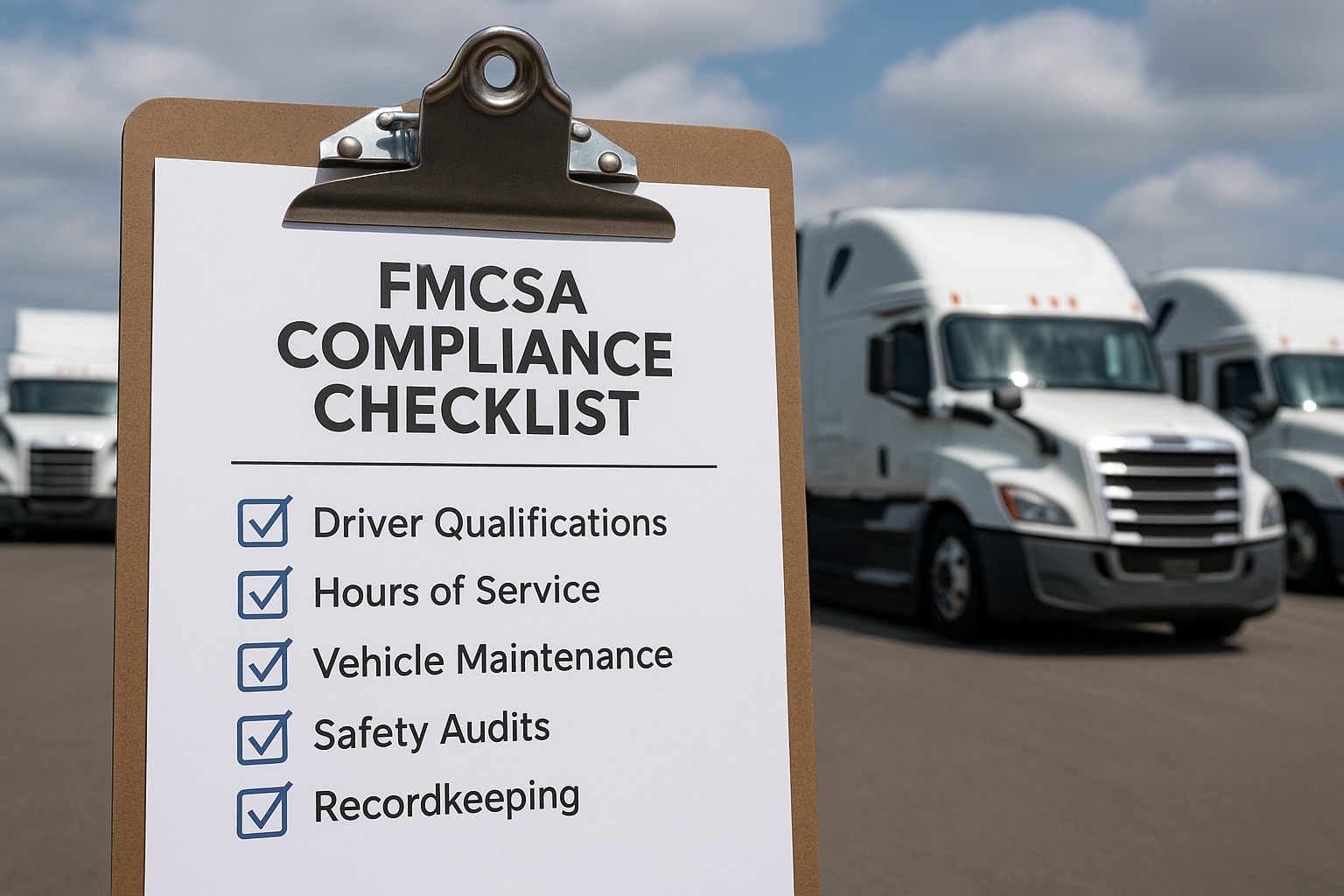The Cost of Compliance vs. Non-Compliance
Strategic FMCSA compliance delivers measurable financial benefits beyond violation avoidance:
$50K+
Annual savings
98%
Compliance rate
40%
Lower insurance
75%
Fewer audits
Essential FMCSA Compliance Categories
1. Driver Qualification Files (DQF)
Critical PriorityRequirements: CDL, medical certificate, MVR, employment application, road test
Update Frequency: Annual MVR, biennial medical, continuous monitoring
Common Violations: Missing documents, expired medical cards
2. Hours of Service (HOS) Compliance
Daily EssentialKey Rules: 11-hour driving, 14-hour duty, 30-minute breaks, 60/70-hour limits
Technology: ELD mandate compliance, backup systems, edit protocols
Audit Focus: False logs, missing data, personal conveyance abuse
3. Vehicle Maintenance & Inspection
Asset ProtectionDocumentation: Annual inspections, DVIR, maintenance records, recall compliance
Schedule: PM every 90 days/25,000 miles, brake adjustments, tire monitoring
Retention: 1 year for records, 6 months for DVIRs
4. Drug & Alcohol Testing Program
Zero ToleranceTesting Types: Pre-employment, random (50% drugs/10% alcohol), post-accident
Clearinghouse: Query before hiring, annual checks, violation reporting
Documentation: Testing records, MRO reports, SAP referrals
5. Insurance & Financial Responsibility
Business CriticalMinimums: $750K general freight, $1M hazmat, $5M passengers
Documentation: MCS-90 endorsement, BMC-91 filing, proof of coverage
Best Practice: Carry 2-3x minimums for nuclear verdict protection
Automate Your FMCSA Compliance
Join fleets achieving 98% compliance rates while saving 20 hours weekly on documentation. Never miss a deadline again.
Compliance Cost-Benefit Analysis
| Compliance Area | Non-Compliance Cost | Compliance Investment | Annual ROI (50 trucks) |
|---|---|---|---|
| Driver Files | $15,000 in violations | $5,000 software/admin | $10,000 saved |
| HOS Management | $25,000 violations + accidents | $7,500 ELD/training | $17,500 saved |
| Vehicle Maintenance | $40,000 breakdowns/OOS | $10,000 PM program | $30,000 saved |
| Drug Testing | $50,000 accident liability | $8,000 testing program | $42,000 saved |
| Insurance Compliance | Business shutdown risk | $2,000 monitoring | Invaluable |
| CSA Score Impact | Lost business opportunities | Included above | $50,000+ revenue |
| Total Annual Benefit | $149,500+ | ||
Monthly Compliance Checklist
Weekly Tasks
Every Monday
- Review driver HOS violations
- Check DVIR completion rates
- Verify ELD data transfer
- Monitor CSA scores
Monthly Tasks
First Week
- Audit 10% of driver files
- Review maintenance schedules
- Check insurance renewals
- Update training records
Quarterly Tasks
Every 3 Months
- MVR pulls for all drivers
- Clearinghouse queries
- Mock DOT audit
- Policy updates review
Annual Tasks
Year-End
- Complete file reviews
- Insurance policy analysis
- Compliance training refresh
- Regulatory update planning
Common Compliance Pitfalls & Solutions
❌ Incomplete Driver Files
Risk: $1,270 per missing document
Solution: Digital DQF system with automated expiration alerts and checklist verification
❌ HOS Violations Pattern
Risk: Intervention, increased inspections
Solution: Daily violation reports, driver coaching, route optimization
❌ Missed Vehicle Inspections
Risk: 20% OOS rate, accidents
Solution: Automated PM scheduling, mobile inspection apps
❌ Clearinghouse Failures
Risk: Hiring prohibited drivers
Solution: Pre-employment and annual queries, instant notifications
❌ Poor Record Retention
Risk: Failed audits, fines
Solution: Cloud storage with retention policies, audit trails
❌ Reactive Compliance
Risk: Constant violations
Solution: Proactive monitoring, predictive analytics, continuous training
Building a Compliance Culture
Training Programs
- Monthly safety meetings
- Online compliance courses
- Violation case studies
- Regulatory updates
Result: 50% fewer violations
Incentive Systems
- Clean inspection bonuses
- Compliance scorecards
- Team competitions
- Recognition programs
Benefit: 85% buy-in rate
Technology Tools
- Compliance dashboards
- Mobile driver apps
- Automated alerts
- Real-time monitoring
Savings: 20 hours/week
Audit Readiness
- Monthly self-audits
- Digital documentation
- Corrective action plans
- Mock inspections
Value: 75% pass rate
Master FMCSA Compliance Today
Implement our proven compliance system and join fleets saving $150K+ annually while achieving 98% compliance rates.
Frequently Asked Questions
The costliest violations include: false logbooks ($13,680), using a driver without valid CDL ($6,440), no systematic maintenance program ($5,440), and failure to implement drug/alcohol testing ($5,440). Beyond fines, these violations trigger increased inspections, higher insurance rates, and potential nuclear verdicts. A single serious violation can cost $50,000+ when including indirect costs.
Best practice includes: weekly spot checks of critical items (HOS, DVIR), monthly audits of 10% of driver files, quarterly comprehensive reviews of all compliance areas, and annual mock DOT audits. This frequency catches issues before they become violations, maintains audit readiness, and creates a compliance culture. Fleets following this schedule report 75% fewer violations.
Quality compliance software ($100-200/truck/month) typically delivers 10-15x ROI through: preventing $15,000+ in annual violations, reducing admin time by 20 hours weekly ($40,000 value), improving CSA scores for better freight rates, and lowering insurance premiums by 25%. Most fleets see positive ROI within 60 days through violation prevention alone.
CSA scores affect: insurance premiums (poor scores increase rates 40%), customer contracts (many require scores below 50), driver recruitment (drivers prefer safe fleets), and DOT inspection frequency. A 20-point score improvement typically results in $50,000+ annual benefits through lower insurance, better freight rates, and reduced inspections. Good scores are a competitive advantage.
In-truck requirements: driver's license, medical certificate (unless filed with state), current logbook/ELD, vehicle registration, insurance card, and any permits. Office retention: complete driver qualification files, maintenance records, drug test results, training documentation. Best practice: use cloud systems allowing instant access to all documents during inspections while maintaining proper originals.








